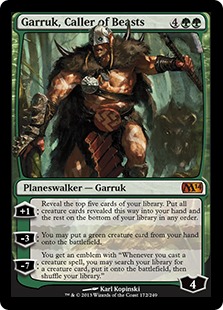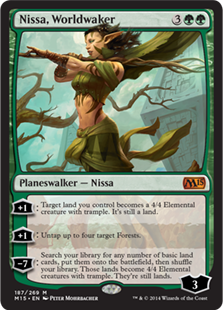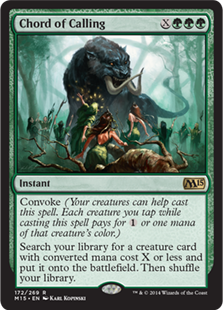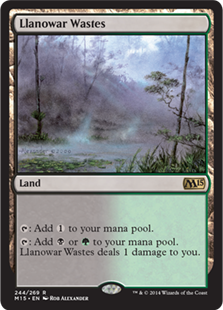
Returning writer DarkRitual explores the deckbuilding opportunities M15 brings to Standard in the first installment of a new monthly series
SCG Baltimore was the first major tournament that M15 was legal in. Looking at the Top 8 doesn't really give any indication of the new core set having a significant effect on the format. The most interesting effect visible in the Top 8 was that you can use Urborg, Tomb of Yawgmoth to give your deck the ability to both swing with a Mutavault or cast Bile Blight on turn two. If we look a little further in the standings, however, we find an archetype that was completely changed by M15.Green is the New Black
Mono-Green Devotion took ninth at SCG Baltimore. It certainly caught my attention despite missing the Top 8. Green Devotion prior to M15 is a deck that has gone in and out of fashion, unable to stake a solid claim in the Standard metagame. For those of you unfamiliar with the deck, the game plan was pretty simple: ramp into something big and smash face. This game plan had a few weaknesses that prevented it from being one of the top decks in Standard.

2. Garruk Is Huge: Without some form of card advantage, a ramp deck will run out of steam quickly. Garruk, Caller of Beasts is the biggest card advantage engine available. In a deck capable of generating over ten mana by turn five, being able to slam Garruk means you have the ability to play multiple creatures a turn and really put pressure on an opponent. Failing to draw Garruk took a lot of gas out of your plays.
3. Few Mana Sinks: The best thing that Mono-Green Devotion could do pre-M15 was generate mana, cast Garruk, and drop a bunch of creatures. That's why Nykthos and Garruk were so vital to the deck. But it didn't help when the backup plan isn't that exciting. The next-best thing to do with that mana was to make Polukranos, World Eater or Arbor Colossus monstrous, or using Nylea, God of the Hunt's pump ability.
As it turns out, the cards from M15 do a lot to help solve these problems.

Note: The list on StarCityGames's website lists only 14 sideboard cards for some reason.
If you want to see a version of this deck in action, Jan van der Vegt (also known by his twitch handle DzyL) has been streaming with the deck. The stream for one of the daily events he went through can be found here.
It still has the old game-plan of ramping up to Garruk and overwhelming your opponent with creatures. Nykthos is still capable of generating crazy mana in the midgame, so that hasn't changed. What has changed is the addition of a few cards from M15.

Genesis Hydra - At first glance, this card seems to be very "win more". If you generate six mana to cast this for X = four, the best case scenario is hitting Courser of Kruphix or Polukranos. If that doesn't happen, this card is very underwhelming. Paying six for a 4/4 that puts a Burning-Tree Emissary into play isn't really where you want to be. What makes the card worth it is that it's another card that you can cast with the 18 mana you generate on turn six. A 16/16 without trample isn't that awesome, but looking for the best non-land permanent in your top 14 cards is. In a deck that is lacking good mana sinks and so desperately wants to find key cards like Garruk to put the proverbial nail in the coffin, casting Genesis Hydra is exactly what you want to be doing.
Nissa, Worldwaker - This is Mono-Green, so of course Nissa is going to be involved. We've yet to see the impact she could have in other decks, but the ability to untap up to four forests in a mono-green list is very relevant. This actually makes it possible to "go off" without Nykthos. Nissa on the board gives you access to at least nine mana the turn after you cast her. The turn you DO cast her, you can instantly untap four lands and drop something else. The crazy thing about this is that untapping forests is the worst of the "plus" abilities. Turning a land into a 4/4 - potentially indestructible - trampler is big. This gives the deck another win condition. Most importantly, it is a win condition that doesn't rely on ramping to 14 mana.

However, this weakness is also why Chord has the potential to be bonkers in a deck like Mono-Green Devotion. Not only does the deck generate ridiculous mana, but also you tend to have untapped creatures in play to help you cast Chord. The ability to cast the card at instant speed also allows for you to play around multiple cards at once. You can play around a Supreme Verdict with an instant Soul of New Phyrexia. Or simply search for a creature after a Verdict resolves. Or respond to an Elspeth, Sun's Champion by searching for a Phyrexian Revoker, naming Elspeth. If Elspeth's tokens are already in play, a tutored Polukranos or Nylea will allow you to fight past them. Reclamation Sage in the toolbox deals with numerous enchantments and artifacts. Creatures like Arbor Colossus can block Stormbreaths at instant speed. For even more mana there is Hornet Queen. Of course, sometimes you just want to be able to play creatures at the end of their turn to mess with their combat math or force them to tap out during their own turn to counter it.
It's possible that when the dust settles, Chord of Calling won't be in the final version of the deck. But Chord's existence for the next year gives this archetype another tool to test out.
To Shock or Not To Shock
Something that is potentially interesting is the addition of enemy-colored painlands to the metagame. There are a lot of two-color decks (such as R/w Burn, B/g, and B/w) that will mindlessly jam four of these in to make their manabases even more consistent. The question of what role painlands will play in three-color decks is a lot more complex.
There is a case to be made for having painlands replace shocklands in three-color midrange decks. This switch seems like crazy talk considering how shocklands are far more common in the non-rotating formats. Standard, however, is a completely different animal. Sac-lands in Modern/Legacy make a huge difference, and Standard is much slower.

Once you get past the initial turn you played the painland or shockland, the issue becomes how many more times you are going to tap Llanowar Wastes for colored mana. With only four painlands in the deck - the rest being shocklands or scrylands - it's easy to see scenarios where the painland is used for colored mana twice or less. When your manabase stabilizes you will usually have enough shocklands and scrylands for your colored mana needs.
I'm not advocating always playing painlands over shocklands, but it's an interesting debate. Obviously there is a downside to painlands. There will be games where it was the only green source you drew for the first three turns, and after that you still needed to use it to cast double-green spells. In those situations you will quickly find that you are taking far more damage than you need to.
Chris Vanmeter actually made the point in a recent article against taking out shocklands for painlands. The existence of Scavenging Ooze in his deck meant that more often than not he would be consistently tapping that painland for green mana early in games. Playing a shockland and getting the two damage out of the way was a much better trade. Notably, he still ended up swapping a forest for a painland.
Moving Forward
While it doesn't seem like there are many Thragtusk-like format-warping cards in this core set, there are many solid cards that could play different roles in various decks. I'm looking forward to what the metagame is going to look like as we get closer and closer to October. We'll probably see an archetype try to make a run and unseat one of the "Big Four". It could be a deck that is far under the radar, or it could be Mono-Green Devotion. Only time will tell!
-
View User Profile
-
Send Message
Posted Aug 17, 2014-
View User Profile
-
Send Message
Posted Aug 17, 2014-
View User Profile
-
Send Message
Posted Aug 18, 2014-
View User Profile
-
Send Message
Posted Aug 18, 2014-
View User Profile
-
Send Message
Posted Aug 21, 2014i thought m15 out rotates m14 not kot.
-
View User Profile
-
Send Message
Posted Aug 21, 2014They are still both in Standard.
-
View User Profile
-
Send Message
Posted Aug 17, 2014-
View User Profile
-
Send Message
Posted Aug 17, 2014I'm not a pro player by any means... but Chris Vanmeter had this to say in an article after the first week of M15 standard.
http://www.starcitygames.com/article/28984_Rats.html
Now, ultimately he tested it and found out you would rather have the Overgrown Tombs, but the general point is that there is actually a question in 3 color decks of which lands to play between Shocks and Pain lands. And CVM actually went into testing assuming Llanowar Wastes would be better.
Exhibits B and C are the Jund Monsters decks from the top 8 of the Pro Tour. 4 Llanowar Wastes, only 2 Overgrown Tombs in both of the decks. One of those Jund Monsters decks plays Nissa, so playing a Pain-land over a shockland that is also a Forest is meaningful.
-
View User Profile
-
Send Message
Posted Aug 20, 2014